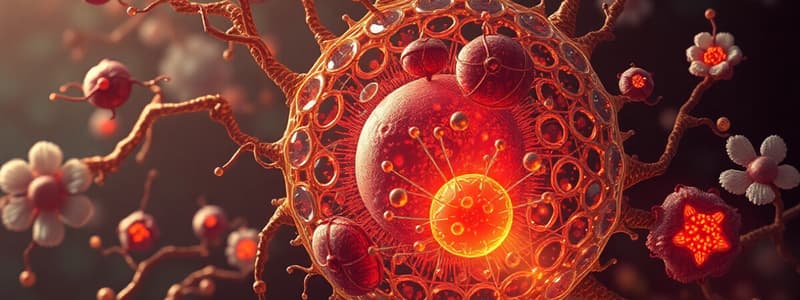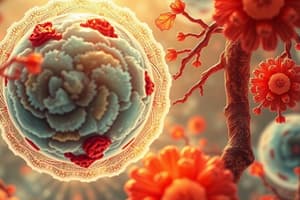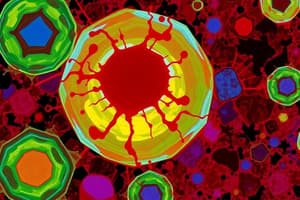Podcast
Questions and Answers
Which condition is more damaging due to the lack of nutrients supplied to cells?
Which condition is more damaging due to the lack of nutrients supplied to cells?
- Hypoxia
- Radiation
- Physical trauma
- Ischemia (correct)
What is a key characteristic of apoptosis?
What is a key characteristic of apoptosis?
- Swelling of many cells
- Membrane blebbing while maintaining integrity (correct)
- Inflammation and cell lysis
- Random degradation of DNA
Which mechanism is responsible for damaging cells by creating unstable atoms?
Which mechanism is responsible for damaging cells by creating unstable atoms?
- Free radical formation (correct)
- Nutritional deficiencies
- ATP depletion
- Increased intracellular calcium
What type of necrosis is specifically associated with tuberculosis?
What type of necrosis is specifically associated with tuberculosis?
Which of the following phases is NOT part of wound healing?
Which of the following phases is NOT part of wound healing?
Which type of trauma leads directly to physical injury in cells?
Which type of trauma leads directly to physical injury in cells?
Which nutrient deficiency can cause cellular injury?
Which nutrient deficiency can cause cellular injury?
What primarily distinguishes necrosis from apoptosis?
What primarily distinguishes necrosis from apoptosis?
Ionizing radiation primarily causes damage through which mechanism?
Ionizing radiation primarily causes damage through which mechanism?
What is the characteristic feature of an autosomal dominant disorder?
What is the characteristic feature of an autosomal dominant disorder?
Which of the following genetic disorders is classified as autosomal recessive?
Which of the following genetic disorders is classified as autosomal recessive?
What is the role of DNA methylation in gene expression?
What is the role of DNA methylation in gene expression?
Which of the following features is associated with Down Syndrome?
Which of the following features is associated with Down Syndrome?
Which of these is a characteristic symptom of Osteogenesis Imperfecta?
Which of these is a characteristic symptom of Osteogenesis Imperfecta?
What is a common physical characteristic of Turner Syndrome?
What is a common physical characteristic of Turner Syndrome?
What is the purpose of the Quad Screen test performed during pregnancy?
What is the purpose of the Quad Screen test performed during pregnancy?
What distinguishes X-linked recessive disorders from other types?
What distinguishes X-linked recessive disorders from other types?
What is likely to happen if two parents with achondroplasia have a child?
What is likely to happen if two parents with achondroplasia have a child?
Which condition is characterized by the presence of an additional X chromosome in males?
Which condition is characterized by the presence of an additional X chromosome in males?
What does amniocentesis specifically analyze?
What does amniocentesis specifically analyze?
Which of the following correctly describes mitochondrial inheritance?
Which of the following correctly describes mitochondrial inheritance?
What is a distinguishing feature of Fragile X syndrome?
What is a distinguishing feature of Fragile X syndrome?
Which chromosomal disorder is associated with a break and rearrangement of chromosomes?
Which chromosomal disorder is associated with a break and rearrangement of chromosomes?
Which of the following describes the phenotype of a child with cystic fibrosis?
Which of the following describes the phenotype of a child with cystic fibrosis?
At what stage of pregnancy is cell-free DNA testing typically performed?
At what stage of pregnancy is cell-free DNA testing typically performed?
What can be said about heterozygous individuals?
What can be said about heterozygous individuals?
What is a common characteristic of individuals with Klinefelter syndrome?
What is a common characteristic of individuals with Klinefelter syndrome?
Which prenatal test involves the collection of placental tissue?
Which prenatal test involves the collection of placental tissue?
Which disorder is associated with trisomy of chromosome 21?
Which disorder is associated with trisomy of chromosome 21?
Match the type of cellular injury with its description:
Match the type of cellular injury with its description:
Match the mechanisms of cellular injury with their effects:
Match the mechanisms of cellular injury with their effects:
Match the characteristics of apoptosis and necrosis:
Match the characteristics of apoptosis and necrosis:
Match the types of necrosis with their descriptions:
Match the types of necrosis with their descriptions:
Match the phases of wound healing with their processes:
Match the phases of wound healing with their processes:
Match the key features of apoptosis with their physiological roles:
Match the key features of apoptosis with their physiological roles:
Match the causes of cellular injury with their effects:
Match the causes of cellular injury with their effects:
Match the terms with their appropriate definitions in cellular injury:
Match the terms with their appropriate definitions in cellular injury:
Match the types of cellular injury with their examples:
Match the types of cellular injury with their examples:
Match the following chromosomal disorders with their key characteristics:
Match the following chromosomal disorders with their key characteristics:
Match the prenatal tests with their primary purpose:
Match the prenatal tests with their primary purpose:
Match the chromosomal disorder with its associated characteristic:
Match the chromosomal disorder with its associated characteristic:
Match the components of the Quad Screen with their respective biomarkers:
Match the components of the Quad Screen with their respective biomarkers:
Match the chromosomal disorder with the gender typically affected:
Match the chromosomal disorder with the gender typically affected:
Match the following prenatal tests with their timing:
Match the following prenatal tests with their timing:
Match the chromosomal disorders with their karyotype abnormalities:
Match the chromosomal disorders with their karyotype abnormalities:
Match the prenatal test with its description:
Match the prenatal test with its description:
Match the disorder with its typical physical features:
Match the disorder with its typical physical features:
Match the genetic disorder with its inheritance pattern:
Match the genetic disorder with its inheritance pattern:
Match the following mechanisms of gene expression regulation with their descriptions:
Match the following mechanisms of gene expression regulation with their descriptions:
Match the genetic disorder with its clinical sign:
Match the genetic disorder with its clinical sign:
Match the following genetic disorders with their associated mutations:
Match the following genetic disorders with their associated mutations:
Match the following features with their relevant genetic inheritance types:
Match the following features with their relevant genetic inheritance types:
Match the disorder with its specific feature:
Match the disorder with its specific feature:
Match the following genetic conditions with their common signs:
Match the following genetic conditions with their common signs:
Match the genetic disorder to its likelihood of occurrence among children based on parent genotypes:
Match the genetic disorder to its likelihood of occurrence among children based on parent genotypes:
Match the type of genetic disorder with a characteristic:
Match the type of genetic disorder with a characteristic:
Match the following terms with their appropriate definitions:
Match the following terms with their appropriate definitions:
Flashcards
Cellular Injury
Cellular Injury
Damage to cells due to their inability to adapt to environmental stressors.
Ischemia
Ischemia
Lack of blood flow to a region, leading to oxygen and nutrient deprivation.
Hypoxia
Hypoxia
Lack of oxygen, often causing discoloration and changes in pulse.
Free Radical Formation
Free Radical Formation
Signup and view all the flashcards
Apoptosis
Apoptosis
Signup and view all the flashcards
Necrosis
Necrosis
Signup and view all the flashcards
Inflammation (Wound Healing)
Inflammation (Wound Healing)
Signup and view all the flashcards
Apoptosis vs. Necrosis
Apoptosis vs. Necrosis
Signup and view all the flashcards
Physical Trauma
Physical Trauma
Signup and view all the flashcards
Chemical Injury
Chemical Injury
Signup and view all the flashcards
Autosomal Dominant Disorder
Autosomal Dominant Disorder
Signup and view all the flashcards
Autosomal Recessive Disorder
Autosomal Recessive Disorder
Signup and view all the flashcards
X-linked Recessive Disorder
X-linked Recessive Disorder
Signup and view all the flashcards
DNA Methylation
DNA Methylation
Signup and view all the flashcards
microRNA
microRNA
Signup and view all the flashcards
Homozygous
Homozygous
Signup and view all the flashcards
Heterozygous
Heterozygous
Signup and view all the flashcards
Genetic Disorder
Genetic Disorder
Signup and view all the flashcards
Osteogenesis Imperfecta
Osteogenesis Imperfecta
Signup and view all the flashcards
Cystic Fibrosis
Cystic Fibrosis
Signup and view all the flashcards
Fragile X Syndrome
Fragile X Syndrome
Signup and view all the flashcards
Down Syndrome
Down Syndrome
Signup and view all the flashcards
Turner Syndrome
Turner Syndrome
Signup and view all the flashcards
Klinefelter Syndrome
Klinefelter Syndrome
Signup and view all the flashcards
Ultrasound
Ultrasound
Signup and view all the flashcards
Quad Screen
Quad Screen
Signup and view all the flashcards
Cell-free DNA
Cell-free DNA
Signup and view all the flashcards
Amniocentesis
Amniocentesis
Signup and view all the flashcards
Chorionic Villus Sampling (CVS)
Chorionic Villus Sampling (CVS)
Signup and view all the flashcards
What are some examples of common prenatal tests?
What are some examples of common prenatal tests?
Signup and view all the flashcards
Radiation Injury
Radiation Injury
Signup and view all the flashcards
Increased Intracellular Calcium
Increased Intracellular Calcium
Signup and view all the flashcards
Homologous Chromosomes
Homologous Chromosomes
Signup and view all the flashcards
Hemophilia
Hemophilia
Signup and view all the flashcards
What are the purposes of prenatal tests?
What are the purposes of prenatal tests?
Signup and view all the flashcards
Study Notes
Cellular Injury
- Cellular injury occurs when cells cannot adapt to their environment.
- Major causes:
- Ischemia: Lack of blood flow, depriving cells of oxygen and nutrients, and preventing removal of harmful metabolites. More damaging than hypoxia.
- Hypoxia: Lack of oxygen; indicated by discoloration and pulse ox changes.
- Physical trauma: Cutting or blunt force injury.
- Radiation (ionizing, nonionizing, UV): Disrupts organelles via reactive oxygen species (ROS).
- Chemical: Blocks DNA synthesis, damages cells directly (drugs, heavy metals, industrial chemicals).
- Nutritional deficiencies: Lack of necessary vitamins and minerals.
Mechanisms of Cellular Injury
- Free radical formation: Unstable atoms damage cells, causing illness and aging. Degrades the lipid bilayer.
- ATP depletion: Reduced energy for cellular functions.
- Increased intracellular calcium: Disrupts cellular processes.
Apoptosis vs. Necrosis
-
Apoptosis: Programmed cell death.
- Cell shrinks.
- One cell primarily affected.
- Cell contents ingested by neighbouring cells.
- No inflammation.
- Membrane blebbing but integrity maintained.
- Apoptotic bodies form.
- Mitochondria release pro-apoptotic proteins.
- Chromatin condensation and non-random DNA degradation.
- Physiological (ageing cell removal) or pathological (dysfunction leading to cancer).
- Uses caspase enzymes.
-
Necrosis: Uncontrolled cell death.
- Cell swells.
- Many cells affected.
- Inflammation noted.
- Cell contents ingested by macrophages.
- Loss of membrane integrity.
- Cell lysis occurs.
- Organelle swelling and random DNA degradation.
- Different types (coagulative, liquefactive, fat, caseous).
Wound Healing
- Inflammation: Blood clot formation, attraction of neutrophils and macrophages to remove dead cells and bacteria.
- Proliferative: Fibroblasts build extracellular matrix to close wound edges.
- Remodeling: New fibrous tissue forms, then degrades.
Genetic Disorders
Levels of DNA Organization
- Chromosomes consist of tightly coiled DNA.
- Humans have 23 homologous chromosome pairs.
- Homologous chromosomes: Chromosome pairs with corresponding DNA, one from each parent.
- Homozygous: Identical alleles at corresponding loci (e.g., type O blood).
- Heterozygous: Different alleles at corresponding loci (e.g., AB blood type).
Gene Expression Regulation
- Gene expression can be modified without altering DNA sequence.
- Induction: Activating a gene.
- Repression: Deactivating a gene.
Epigenetic Mechanisms
- DNA methylation: Prevents transcription by adding methyl groups to DNA.
- microRNA: Inhibits translation by binding to mRNA.
Mendelian Inheritance and Genotype/Phenotype Prediction
- Determine child's genotype and phenotype (disease or no disease) given parent genotypes (autosomal dominant, recessive, X-linked recessive).
Types of Genetic Disorders
- Autosomal Dominant: One altered gene copy causes disease. 50% chance of inheritance.
- Autosomal Recessive: Two altered gene copies needed.
- X-linked Recessive: Mutation on X chromosome. Males typically affected.
- Mitochondrial Inheritance: Inherited from the mother.
- Chromosomal Disorders: Breaks, rearrangements, or deletions in chromosomes (e.g., Down, Turner, Klinefelter).
- Multifactorial Disorders: Multiple factors contribute (lifestyle, environment and genes).
Clinical Signs and Causes of Genetic Disorders
- Autosomal Dominant:
- Osteogenesis imperfecta: Brittle bones, bowed legs (collagen mutation).
- Marfan syndrome: Tall, slender build, aortic issues, lens dislocation (fibrillin-1 mutation).
- Huntington's disease: Movement and cognitive decline (CAG repeat mutation).
- Neurofibromatosis: Café au lait spots, tumors (nerve mutation).
- Achondroplasia: Short limbs, dwarfism (FGFR3 mutation).
- Autosomal Recessive:
- Cystic fibrosis: Respiratory and digestive issues (CFTR mutation).
- Sickle cell anemia: Anemia, pain, sickled RBCs (hemoglobin mutation).
- X-linked Recessive:
- Hemophilia: Bleeding disorder (clotting factor mutation).
- Duchenne muscular dystrophy: Muscle weakness (dystrophin mutation).
- Mitochondrial Inheritance: Chronic progressive external ophthalmoplegia.
- Chromosomal Disorders: Specific features for each (Down, Turner, Klinefelter).
Prenatal Testing
- Ultrasound: Structural abnormalities.
- Maternal Serum Biomarkers: (Quad Screen) AFP, hCG, inhibin A, estriol.
- Cell-free DNA: Measures fetal DNA in maternal blood for chromosomal abnormalities.
- Amniocentesis: Invasive test of amniotic fluid.
- Chorionic Villus Sampling: Invasive test of placental tissue (10-13 weeks).
Studying That Suits You
Use AI to generate personalized quizzes and flashcards to suit your learning preferences.




